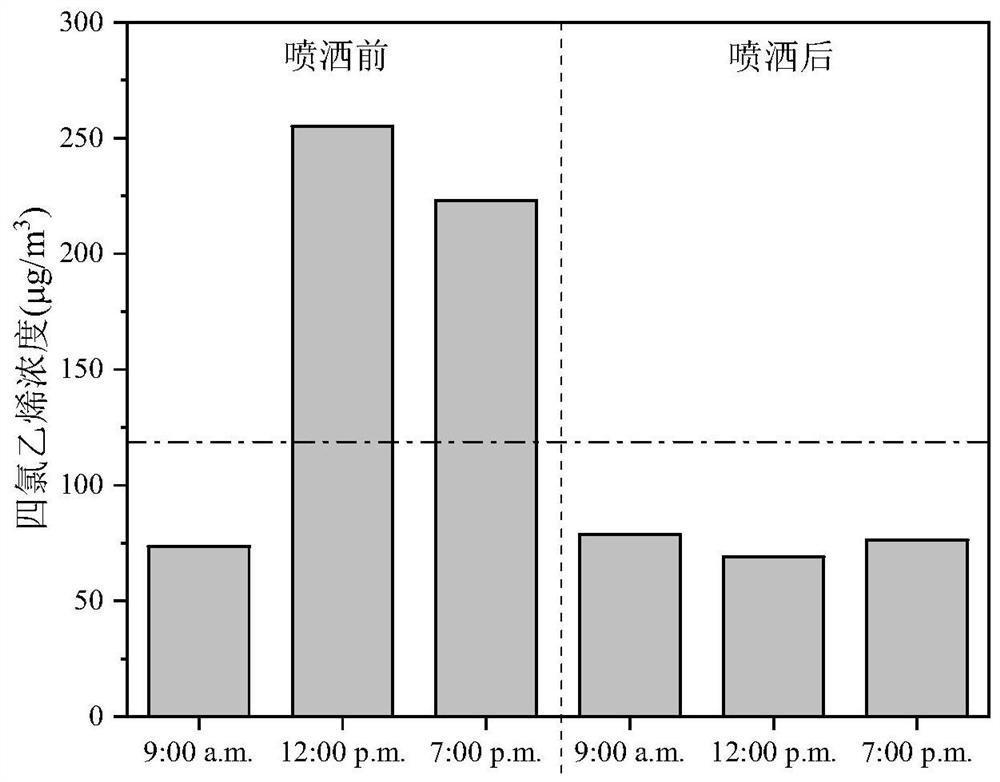Method for oxidizing tetrachloroethylene pollutants in household garbage room by chlorine-containing oxidant
A technology for domestic waste and tetrachloroethylene, applied in the field of domestic waste pollutant treatment, can solve the problems of poor removal effect of tetrachloroethylene, increased VOCs concentration, weak ozone stability, etc., to limit phototoxic side effects and achieve unmanned Operation, no secondary pollution effect
- Summary
- Abstract
- Description
- Claims
- Application Information
AI Technical Summary
Problems solved by technology
Method used
Image
Examples
Embodiment 1
[0030] A method for chlorine-containing oxidizing agent to oxidize tetrachlorethylene pollutants in domestic garbage houses:
[0031] A slightly acidic electrolyzed water generator (voltage 24V; current 2.5A) is equipped in a household garbage room in a community in Shanghai, and 8 nozzles (diameter 150mm; spray rate 1.6) are evenly distributed on the top along the length of the household garbage room. mL / min).
[0032] 9% dilute hydrochloric acid is electrolyzed in a diaphragmless electrolytic cell of a slightly acidic electrolyzed water generator to generate slightly acidic electrolyzed water with a pH of 5.0-6.5 and an available chlorine content of 50-100 mg / L.
[0033] The slightly acidic electrolyzed water generator is connected to a high-pressure nozzle sprayer (pressure 6.0MPa; maximum flow rate 1.6L / min). The slightly acidic electrolyzed water generated by the slightly acidic electrolyzed water generator is atomized by a high-pressure nozzle sprayer, and then vertical...
Embodiment 2
[0036] A method for oxidizing tetrachlorethylene pollutants in a household garbage room with a chlorine-containing oxidant, the method comprising: installing a slightly acidic electrolyzed water generator in the household garbage room, electrolyzing low-concentration dilute hydrochloric acid to generate hypochlorous acid as the main oxidizing component The slightly acidic electrolyzed water is then atomized and sprayed in the domestic garbage room to oxidize the tetrachlorethylene pollutants in the domestic garbage room.
[0037] Among them, the voltage of the slightly acidic electrolyzed water generator is 12V, and the current is 2A. In low-concentration dilute hydrochloric acid, the mass fraction of HCl is 9%. The pH value of slightly acidic electrolyzed water is 6.0, and the available chlorine content is 70mg / L.
[0038]The domestic garbage room is equipped with a high-pressure nozzle sprayer, and the obtained slightly acidic electrolyzed water is atomized through the high...
Embodiment 3
[0041] A method for oxidizing tetrachlorethylene pollutants in a household garbage room with a chlorine-containing oxidant, the method comprising: installing a slightly acidic electrolyzed water generator in the household garbage room, electrolyzing low-concentration dilute hydrochloric acid to generate hypochlorous acid as the main oxidizing component The slightly acidic electrolyzed water is then atomized and sprayed in the domestic garbage room to oxidize the tetrachlorethylene pollutants in the domestic garbage room.
[0042] Among them, the voltage of the slightly acidic electrolyzed water generator is 36V, and the current is 3A. In low-concentration dilute hydrochloric acid, the mass fraction of HCl is 10%. The pH value of slightly acidic electrolyzed water is 5.0, and the available chlorine content is 100mg / L.
[0043] The domestic garbage room is equipped with a high-pressure nozzle sprayer, and the obtained slightly acidic electrolyzed water is atomized through the h...
PUM
 Login to View More
Login to View More Abstract
Description
Claims
Application Information
 Login to View More
Login to View More - R&D
- Intellectual Property
- Life Sciences
- Materials
- Tech Scout
- Unparalleled Data Quality
- Higher Quality Content
- 60% Fewer Hallucinations
Browse by: Latest US Patents, China's latest patents, Technical Efficacy Thesaurus, Application Domain, Technology Topic, Popular Technical Reports.
© 2025 PatSnap. All rights reserved.Legal|Privacy policy|Modern Slavery Act Transparency Statement|Sitemap|About US| Contact US: help@patsnap.com

